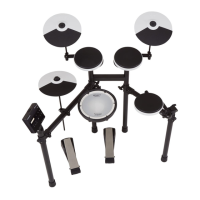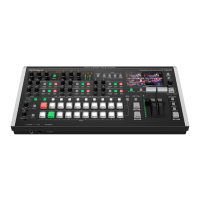23
Performing Along with a Song
Playing Back the Click Along with the Song
Separately from the audio le (WAV) that contains the song, you can use an audio le (WAV) that contains a click sound and
play it as the click track. Since the click track plays simultaneously with the song, this is convenient when you want to play a
click sound along with a favorite song.
* To play back a click track, you must prepare a song and a click audio le in WAV format. MP3 les are not supported.
Preparing a Click Track
1. Separately from the audio le (WAV)
containing the song, provide an audio
le (WAV le) that you will play back
simultaneously as the click track.
2. On your computer, edit the le name of the le
that you prepared in step 1.
Specify “song le name+_Click” as the name of the audio
le that you want to play as the click track.
Example)
If you want the click track to play back along with a song
named “TD-27.wav” then you would specify “TD-27_Click.
wav” as the name of the click audio le.
3. Save the song audio le and the click audio le
in the top directory of the SD card (p. 22).
In the case of the example, save “TD-27.wav” and “TD-27_
Click.wav” in the same level.
Playing Back the Click Track Along with the
Song
1. Press the [SONG] button.
The SONG screen appears.
2. Press the [F1] button several times to select
“SD CARD.”
3. Use the dial to select the song that you want to
play back together with the click track.
In the case of the example, select the song “TD-27. wa v.”
4. Press the [F5] button to specify “CLICK ON.”
5. Press the [
s
] button.
The click track plays together with the song playback.
MEMO
5 To adjust the volume of the click track relative to the
song, adjust Click Track Level or Song Level.
&“Viewing and editing song information” (p. 22)
In the case of the above example, use Song Level to
adjust the volume of “TD-27.wav” and use Click Track
Level to adjust the volume of “TD-27_Click.wav.”
5 To mute the click track, press the [F5] button to specify
“CLICK OFF.”
5 You can also output the click track only to headphones.
&“Audio Output Assignments (OUTPUT)” (p. 55).

